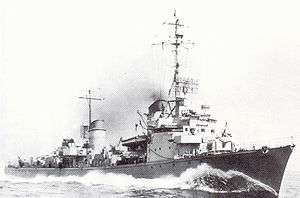Battle of Nerva Island
| Battle of Nerva Island | |||||||
|---|---|---|---|---|---|---|---|
| Part of the Eastern Front of World War II | |||||||
 T-35, of same Elbing-class like T-31 and T-30 | |||||||
| |||||||
| Belligerents | |||||||
|
|
| ||||||
| Commanders and leaders | |||||||
|
|
| ||||||
| Strength | |||||||
| 2 torpedo boats |
Minor units of the Soviet Baltic Fleet (4 gunboats, 10 patrol boats, 14 motor torpedo boats) | ||||||
| Casualties and losses | |||||||
|
1 torpedo boat sunk, 1 torpedo boat damaged 78 killed, 21 wounded, 6 captured |
8 units damaged unknown human losses | ||||||
The Battle of Nerva Island was a battle in the Gulf of Finland during World War II on 19–20 June 1944 between the Soviet Union and the Germany, occurred amid the 1944 Soviet offensive against Finland. It was one of the few engagements in the Baltic theater with large surface ships.
Background
Nerva (or Narvi) Island was a strategic target conquered by the Soviet forces in preparation for the following Battle of Vyborg Bay (1944). The Kriegsmarine begun the "Operation Drosselfang" on Koivusaari/Piisaari area, to attack Soviet small ships supporting the combined Soviet operations. The action was relevant for the involvement of German large surface vessels: the Elbing-class fleet torpedo boats T-30 and T-31.[1]
Battle
No major Soviet warships were in action (most of them were blocked in Leningrad), and the Soviet Navy engaged possessed in the area 4 small gunboats, 10 patrol boats (MO-4 class submarine chasers), and 14 motor torpedo boats.[2] German torpedo boats shelled the soviets but caused only damage to the two gunboats MBK-503, MBK-505 and on the MO-106, without sinking them. The Soviets counter-attacked with their motor torpedo boats: the first attack was repelled with damages on TK-53, TK-63 and TK-153, while the second attack was another failure with damages on TK-101 and TK-103. Finally, TK-37 and TK-60[3] made a pincer attack and launched their torpedoes at the same time against T-31: The German torpedo boat was hit and sunk. Other sources give credit to the victory only to TK-37.[4] 76 German sailors lost their lives, while 6 were captured by Soviets. Finnish units rescued other German sailors (including 23 wounded, two died of wounds[5]). After the loss of her sister-ship, T-30 retreated after having suffered light damages (one sailor killed and 13 wounded). Germans claimed to have sunk a number of Soviet attacking motor torpedo boats but actually despite some were damaged, none was sunk.
Aftermath
The battle resulted in a rare naval victory for the Soviets: Germans failed to sink any Soviet ship, while losing a torpedo boat. The following month, on 16 July 1944, The Germans attempted a repetition of the mission (“Operation Buckenwald”) engaging the torpedo boats T-30, T-8 and T-10: the action resulted in a brief inconclusive skirmish with Soviet torpedo boat Tucha and minesweepers Tszcz-211 Rym and Tszcz-217 Kontr-Admiral Yurkovskiy. No damage occurred to the major warships, while shortly before the fight the Soviets suffered damages on two small patrol boats.[6]
References
- ↑ "Baltic Sea, 19./20. June 1944 Operation Drosselfang - Axis History Forum". Forum.axishistory.com. Retrieved 2016-01-12.
- ↑ "Ship Forum :: Re: T-22, T-30 and T-32". Warsailors.com. Retrieved 2016-01-12.
- ↑ "1939 type torpedo boats (T22, 1942 - 1944) - Kriegsmarine (Germany)". Navypedia.org. Retrieved 2016-01-12.
- ↑ Michael Emmerich. "Flottentorpedoboot T31 History". German-navy.de. Retrieved 2016-01-12.
- ↑ "Sundverbung Wofgang Müller and his son / Цусимские форумы". Tsushima.su. Retrieved 2016-01-12.
- ↑ "Soviet Naval Battles - Baltic Sea during WW2 (re-done) - Soviet-Empire.com U.S.S.R". Soviet-empire.com. Retrieved 2016-01-12.